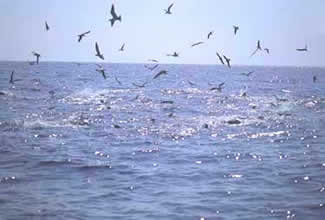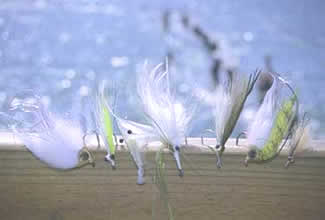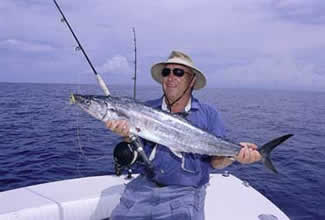May 16, 2011
By David Conway
Key West waters are top drawer for bluewater and wreck fly fishing.

Blackfin tunas and bonito rise briefly to baitfish over an Atlantic-side wreck. |
There's no arguing that Florida is the cradle of saltwater fly fishing. And at the end of the road, Key West's pioneering anglers opened the doors to what is arguably the best wreck and bluewater fly fishing on Earth. The amazing variety of species in these fertile waters spurred fly fishers to try everything and anything, as a quick glance at the record books will attest.
You want variety? Blackfin tuna season starts in November on the Atlantic side and goes right through June on the Gulf side behind the shrimp boats. Sailfish and amberjack appear in winter and run strong through spring. Cobia appear around November on the inshore and offshore wrecks, and in December they move into shallow water, the harbor and the Northwest Channel, along with snapper, blacktip sharks and bull sharks, barracuda and permit. Now throw in the mackerels—kings, Spanish and cero. All of these gamesters take a fly, and are present in great numbers from March through June on both the Atlantic and Gulf side of Key West.
Many of the locally proven offshore flyfishing techniques, only now gaining popularity elsewhere, were developed and refined over 30 years ago in these waters by the likes of Capts. Ralph Delph, Ken Harris, Robert Trosset and Jose Wejebe. And three basic strategies for catching pelagics on fly still make the grade: chumming behind Gulfside shrimp boats, teasing with live baits over Gulfside wrecks, and live chumming with pilchards on wrecks and other hotspots in the open Atlantic. The common denominator to these techniques is chum. It's a big ocean out there, so it's a must to attract the fish into flyrod range, and keep them there.
Come spring in the Lower Gulf, blackfin tuna, bonito, kings and cobia flock to the shrimp boats to feed on bycatch when shrimpers cull the catch. Most blackfins come to anchored shrimp boats anywhere from 20 to 40 miles out of Key West. Some anglers barter with shrimpers on the spot for bags of various dead marine life—baitfish and crabs mostly. You can also buy suitable chum at some Key West marinas and baithouses.
Fish that are drawn to shrimp boats quickly respond to a few handfuls of chum thrown off your stern. Aggressive bonito usually surface first, while blackfins hang deeper. Be patient—tuna will rise after a few minutes. There are a couple of tricks you can use to separate the bonito from the blackfins. For starters, cast fly patterns that mimic tuna forage. There are pufferfish and squid patterns available, and bonito don't light up to them. Also, as you drift away from a shrimp boat, bonito will run back to it while tuna tend to stick with you as long as you chum them.
Kings skyrocket and then sound.
|
|
Then there's the bait-and-switch method. Teasing with hooked live baits over wrecks and casting flies to hot fish is exciting to say the least, especially when big cobia, amberjacks and barracudas are under your boat. This tactic requires numbers for good, productive wrecks and coordination among those on board. Often, you'll draw multiple species over a wreck, and if you are selective about what you want to hook, it's a challenge to choose your fish from the crowd and then get a fly into position so that others won't beat it to the punch.
The third style, chumming with live pilchards, brings a lot of tackle-busting fish close enough to boats to reach with a fly rod. The drill is to net pilchards in the shallows before heading to the Atlantic side where blackfins, kings, plus passing cobia and sailfish may materialize. Tuna will often crash bait some distance from the boat, and when the entire pod is moving, accurate casting is required. When you're anchored at a color change or a rip and the current's running at a few knots, you'll get a workout should you hook 20-plus-pound blackfin, which commonly sound to a depth of a hundred feet or more.
 |
“Fly fishing for pelagics has changed a lot out of Key West in the last 20 years,” says Capt. Ken Harris, who holds a number of I.G.F.A. records on fly caught aboard his boat, Finesse. “In the mid-'80s, nothing was as cool as teasing, especially over the Gulf wrecks. We wouldn't enter a cobia in the Met Tournament that was less than 50 pounds on fly. Amberjacks had to be 60 or 70 pounds to be noteworthy. By the mid '90s, live-chumming with pilchards became the rage, and you could add yellowfin tuna to the mix.”
Harris claims that in the mid '90s, the prevalence of yellowfins and tiger sharks was related to the position of the loop current in the Gulf. Fifteen years ago the loop swung east and brought those yellowfins close to Key West, but eight years ago it meandered west again. While the yellowfins still show in December and January and tigers are still around, neither are as plentiful as they were.
“Now, if we went out 160 to 180 miles to that current, as a couple of my friends did the other day,” says Harris, “we'd crush the big yellowfin, marlin and tigers.”
“There is nothing constant in saltwater fishing,” Capt. Joe Green adds. “Except that it's constantly changing. The tides, the light, the current, it's never the same as the day before, or even the minute before.”
“You know what's really fun behind the shrimp boats?” asks Harris. “Take a really big popper and let it float and the bonito will suck it down and spit it and finally a tuna will take it and you set the hook and hold on.”
“I think kingfish are the coolest fish that we catch down here on fly on a regular basis,” adds Harris. “Especially when they're going 30 or 40 pounds. I've taken them up to 51 pounds on fly. I like them even better than tuna. Kings skyrocket then sound, and they do require some good casting.”
Then consider that Key West has cero and Spanish right around the reef in the late winter and early spring. Record size ceros and Spanish can be caught on fly by anchoring and chumming over marked fish on the bar, just south of the reef.
“I'd like to see a wahoo on fly,” I said during a discussion with Harris.
"The problem with wahoo is that we're not able to keep them around the boat,” Harris says. “Those schools move so fast, you just can't target them. I don't know anyone who's landed a wahoo on fly out of Key West.”
The opposite is true of cobia. “A nice thing about cobia,” Harris says, “is that you head west to the wrecks in just 10 feet of water and see cobia on top. On cold, sunny January days they're on top sunning, and it's pretty easy fly fishing.” If the cobia stay deep and you can't chum them to the surface, you can try sinking lines and streamers to get to them. Even undersize cobia give a good fight on 9-weight rods.
The best fish to target on fly in Key West, especially for starters in the sport, may be dolphin, because their runs are fairly predictable and they're gullible eaters. Dolphin show by March around Key West with the biggest fish usually in May and June. They remain through late summer, though the big fish do move farther offshore by then.
Wood's Wall, named for Norman Wood, who pioneered the area's marlin fishery, is a prime dolphin spot. The wall drops from about 900 to 2,200 feet in a matter of acres. Other dolphin hotspots close by include The Hooters, named for their resemblance to anatomical features, and The Ups and Downs, presumably named for the character of fishing itself, if not the topography.

Key West waters are famed for smoker kings on fly, over Gulf and Atlantic wrecks. |
I recall a summer day while fishing with friend Joel Day at the Wall when it resembled a desert—no signs of dolphin at all. By midmorning we saw weeds and birds working them in 2,090 feet, so we zoomed over, wheeled and dropped back the baits to troll the weedline. A rod bowed, then the other. I reeled a dolphin close to the bow, and kept it in the water. The school came alongside, swirling and slicing a foot below the surface as swiftly as flying parrots. We soaked a chumbag and doled out a handful of frozen glass minnows, and the schoolies lit up.
Joel had a 9-weight, with light class tippet and no shock leader. I fished a 7-weight outfit with a leader terminating in a 50-pound shock. “That's a good rod for these fish,” he said. The dolphin were under 10 pounds, and every one we hooked did head-over-tail acrobatic jumps. We released them quickly, and we kept enough for ourselves and a few friends to eat that night. Over the radio we heard talk about a blue marlin that appeared in a dolphin school behind another boat, not that unusual an occurrence, and a grand opportunity for anglers who take the time to prepare for it. The report said the fish kept batting the schoolie dolphin out of the water and stealing them. Joel glanced at his 12-weight fly rod tucked into the rack. It suddenly looked kinda light.
While we played dolphin, a sleek fish with stripes like a tiger loomed at the surface of the cobalt water, well within casting range. I saw the fish first and pointed it out to Joel. His head lowered as he locked onto that wahoo, and he headed to the rod rack.
“Nothing,” he announced. “I don't have any wire tippets rigged up.”
Opportunities like that wahoo are fleeting. Same goes for the cobia, tuna, marlin, sailfish, whatever appears when you tote fly rods to the blue off Key West. You can always scale your fly tackle to the fish you plan to target, but it's better to be over-gunned than under-gunned, and that goes for kings and tuna, too.
“I carry four rods, all 12-weights,” Harris says. “I'll rig a popper and floating line on one rod, a steel leader with a streamer on another, and I'll have another, a fast-sinking line, and finally, an outfit with an intermediate mono line. Also, I use direct-drive reels, which can be knuckle-busters for the novice when there's a big fish on. But for big fish like sharks, amberjacks and tuna, direct drive fly reels let you apply much more pressure than anti-reverse reels. Serious big game fly fishermen always choose them.
“As the popularity of bluewater and wreck fly fishing grows, tackle companies are making rod-and-reel outfits that are more affordable. No longer does it take a thousand dollars to buy good gear. You can get a good outfit for half that. But it's worth it to spend the extra money because the fish and the marine environment are so hard on tackle.”
Bluewater and wreck fly fishing doesn't need to be intimidating to beginners either, and might even be more forgiving than the nerve-wracking world of the flats. Unlike fish with water barely covering their backs, bluewater denizens can be caught without perfect, pinpoint casts or silent stalking.
You can always scale fly tackle to fish your target, but it's better to be over-gunned than under-gunned.
|
|
“Whether a guy has never used a fly rod or he is a first-class fly fisher, he has a chance to catch a big fish on fly out here,” says Harris. “There is more frustration to be had when fly fishing on the flats.”
For a perfect example, juxtapose flats permit with wreck permit. I know of two visiting anglers who fished on their own and were frustrated after days of stalking, casting to, but not hooking a single permit on the fabled Key West flats. So they chartered Capt. Joe Green. Green cut the odds in their favor by talking them into a trip to a Gulf wreck where big permit school, and certainly “let their hair down” much more than when in the shallows. Green wrapped a white pipe cleaner around a hook and said, “Here's your fly.” They each released about ten permit that day. You might surmise that there was some chumming involved.
FS

